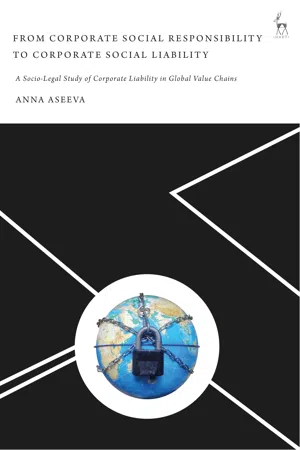
From Corporate Social Responsibility to Corporate Social Liability
A Socio-Legal Study of Corporate Liability in Global Value Chains
- 304 pages
- English
- ePUB (mobile friendly)
- Available on iOS & Android
From Corporate Social Responsibility to Corporate Social Liability
A Socio-Legal Study of Corporate Liability in Global Value Chains
About this book
This book provides a critical socio-legal study that brings together the latest scholarly advances on corporate social responsibility, and, at the same time, addresses the pressing issue of corporate liability for harmful acts across the supply and production chains. Corporations have seldom been held responsible and virtually never liable for the acts of their subsidiaries and subcontractors. Actors as different as workers, investors, individual consumers, and shareholder activists claim that corporations should accept greater responsibility for communities and environments affected by their activities. The book argues that a global value chain's head corporations remain immune to any liability because of the 'economically dependent-legally independent' relationships between core corporations and their periphery suppliers and subcontractors. To tackle this problem, globally, the author acknowledges that 'we' as a society need to reduce the economic dependence as described above – which is far too excessive – by ensuring a level playing field both economically and socially. More concretely, she argues that in order to realise transnational corporate liability, 'we' as lawyers need to find a way (or ways) to establish legally effective relationships between head corporations and their economically dependent entities. Readers of this book will be able to export the concept of corporate social liability, developed in the context of value chains, and apply it to other contexts involving corporate activities where they need to tackle unrestrained corporate freedom and make global businesses responsible and socially useful.
Frequently asked questions
- Essential is ideal for learners and professionals who enjoy exploring a wide range of subjects. Access the Essential Library with 800,000+ trusted titles and best-sellers across business, personal growth, and the humanities. Includes unlimited reading time and Standard Read Aloud voice.
- Complete: Perfect for advanced learners and researchers needing full, unrestricted access. Unlock 1.4M+ books across hundreds of subjects, including academic and specialized titles. The Complete Plan also includes advanced features like Premium Read Aloud and Research Assistant.
Please note we cannot support devices running on iOS 13 and Android 7 or earlier. Learn more about using the app.
Information
Table of contents
- Cover
- Title Page
- Acknowledgements
- Contents
- Abbreviations and Acronyms
- Table of Cases
- Table of Legislation
- PART I: ON THE LIMITS OF LAW AND A LIMITLESS GLOBALISED MARKET
- PART II: THE SHORTCOMINGS OF CORPORATE RESPONSIBILITY AND OBSTACLES TO CORPORATE LIABILITY
- PART III: CORPORATE LIABILITY IN THEORY AND PRACTICE: RECENT APPROACHES AND AN INTRODUCTION TO CORPORATE SOCIAL LIABILITY
- PART IV: PITFALLS AND THE FUTURE OF CORPORATE SOCIAL LIABILITY IN GLOBAL VALUE CHAINS
- Bibliography
- Index
- Copyright Page